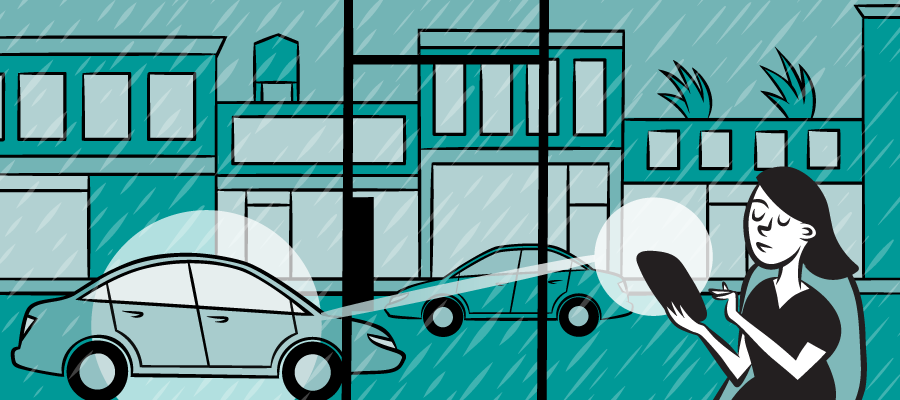What’s missing from the Uber debate? Market power, congestion, pollution, and even deaths
The BC government has introduced legislation expected to bring ride-hailing to the province late next year, though many questions remain about what the outcome will be in practice. A number of important policy details still need to be filled in by the Passenger Transportation Board and ICBC.
Meanwhile the debate on ride-hailing has largely been stuck, with the pro and con sides repeating the same familiar arguments. As a result, important aspects of the story are being overlooked, with major implications for urban congestion, air pollution, greenhouse gas emissions and traffic deaths.
BC has a chance to be truly innovative in designing its ride-hailing framework. This will require rejecting the false choice between a local taxi oligopoly and monopoly-seeking ride-hailing corporations, and recognizing there’s another way forward that can help shape these services in the public interest.
In short, ride-hailing should be run on a non-profit basis, as a co-op or other non-profit model. Instead of the usual practice of taxi companies or multinationals like Uber extracting large fees from drivers, a non-profit model would allow this surplus to be shared by drivers and passengers alike. This approach can also help avoid the social costs imposed when floodgates are opened to expansionist firms like Uber.
The debate as it stands
Let’s recap the ride-hailing debate as it stands. In favour of ride-hailing, proponents typically argue that it would bring faster and cheaper access to vehicle-for-hire transportation. The existing taxi oligopoly, with its total number of vehicles limited by regulation, has inadequately provided these services, especially at times of peak usage. App-based services like Uber would make more rides available, and also provide a more convenient way to book and pay for rides. Ride-hailing helps reduce drunk driving, it is claimed, and might even help some people ditch car ownership altogether.
Opponents argue, though, that bringing in companies like Uber would only create more precarious, unstable work and lower wages for drivers by flooding the market with vehicles-for-hire. Large multinationals like Uber typically extract about 25% of the fare revenue, and this money would flow out of the local community to Silicon Valley. Furthermore, ride-hailing raises safety concerns, as it tends to be much less regulated than traditional taxis, with less training and weaker driver screening and licensing requirements. Opponents can point to reports of sexual harassment and assault and discrimination—though there are similar reports relating to traditional taxis.
These points are all important. But a few crucial issues have been missing from the debate.
The hidden costs of ride-hailing
Ride hailing has major impacts on a city’s broader transportation system. A growing body of evidence from the US shows that when companies like Uber and Lyft enter a market, they increase the total vehicle miles travelled. Ride-hailing has added 2.8 vehicle miles to the roads “for each mile of personal driving removed” in the US. The practice of “deadheading,” where drivers circle the streets waiting for their next passenger, also contributes to the increase in total vehicle miles travelled.
As a result, ride-hailing worsens the existing social costs of urban automobile transportation. Cities like Seattle, New York and San Francisco are grappling with increased congestion linked to the expansion of Uber and Lyft. For example, in Seattle, back in 2012 taxis provided 5.2 million vehicle-for-hire trips, but the two ride-hailing giants were on pace to provide 31 million trips this year.
Ride-hailing has added 2.8 vehicle miles to the roads “for each mile of personal driving removed” in the US. Cities like Seattle, New York and San Francisco are grappling with increased congestion linked to the expansion of Uber and Lyft.
Added to the inconvenience and economic costs of traffic congestion, increasing vehicles miles travelled means more deadly air pollution and higher greenhouse gas emissions. A new study also suggests ride-hailing has caused a 2–3% increase in traffic deaths in the US, equivalent to 1,100 more deaths per year.
Vehicle miles travelled increase with ride-hailing because users are often switching from other modes of travel like walking, cycling and public transit.1 They also simply end up taking more trips overall than they otherwise would.
The enormous social costs of urban automobile transportation can’t be pinned on ride hailing alone. Driving one’s own vehicle still accounts for the vast majority of cars on the road. But the explosion of ride-hailing is making these problems worse, not better.
Market power: Trading one oligopoly for another?
Another element missing from the debate is that ride-hailing tends to be dominated by one or two firms in a given market (even though the charge of “oligopoly” is usually reserved for the taxi industry). That’s as expected and intended. As one Uber analyst and critic put it, the company’s “modus operandi is to subsidize fares and flood streets with its cars to achieve a transportation monopoly.”
The business models of big ride-hailing companies are premised on establishing and profiting from a dominant market position. This is why venture capitalists have been willing to pour billions into Uber even while it has continued to operate at a loss.
And it’s not just ride-hailing companies. We’re living in an era of huge winner-take-all digital platforms such as Facebook, Google, Amazon and others. These companies claim that users are only “one click away” from an alternative, but in reality, these dominant firms benefit from a powerful set of advantages, including what economists call “network effects.”
Network effects are features of certain markets wherein, the more users that participate in a given service, the greater the value of that service. This gives incumbent firms a major leg up and creates a tendency towards one or two companies dominating the market.
Uber and Lyft passengers usually find it unattractive switch to alternative upstarts—if they are even aware of them—because almost all the drivers are on the one or two established apps in their market. In turn, drivers have little incentive to switch to smaller apps because almost all the customers are using Uber or Lyft. It’s a self-reinforcing dynamic, like the one that helps keep Facebook dominant among social networks.2
Ride-hailing markets have shaped up in practice much as theory would suggest: highly concentrated. Uber and Lyft hold almost the entire market share for ride-hailing in the US.3
Wages and value extraction
Does this amount to an argument for preserving the status quo local taxi industry in BC? Not necessarily.
The existing taxi industry is oligopolistic and does not respond well to times of peak demand because of insufficient taxi licenses (to the benefit of owners of these scarce licences). While drivers are sometimes taxi license owners themselves, this is the exception rather than the rule, according to a recent report commissioned for the BC Ministry of Transportation and Infrastructure.
The majority of BC taxi drivers don’t own a taxi license and have to pay “lease fees” to the owners (by the shift, month or year). Typical fees paid by a driver for a 12-hour shift in Vancouver have been estimated at $120. After factoring in these and other costs, real driver wages in Vancouver would typically amount to $12 per hour or less, according to an estimate by analyst Benn Proctor in 2014. These estimates put wages in roughly the same range as recent estimates of Uber wages.4
Whether it’s Uber extracting 25% of fares, or local taxi firms and licence owners extracting their own fees, drivers in both modes are getting the short end of the stick.
Of course, the endgame for Uber and Lyft is to cut drivers out of the equation altogether, as their growing investments and partnerships in self-driving car technology make clear.
Whether it’s Uber extracting 25% of fares, or local taxi firms and licence owners extracting their own fees, drivers in both modes are getting the short end of the stick.
A different way forward: Non-profit, driver-owned ride-hailing
There is another way forward for ride-hailing. Industries that tend towards market concentration are good candidates for alternative models of ownership. Rather than being owned by for-profit multinational corporations or local taxi firms, vehicle-for-hire services in BC should be run on a non-profit basis: owned by their drivers (a co-op model), their communities, or both.
Instead of revenues being siphoned off to investors in taxi licences or corporations like Uber, drivers and passengers could share that surplus, putting it towards higher wages and cheaper fares.
Instead of subjecting our cities to expansionist ride-hailing corporations with deep–pocketed lobbying operations, a non-profit alternative would be easier to regulate and contain as part of a broader transportation strategy that emphasizes public transit and active mobility.
The idea of a non-profit alternative to ride-hailing is being discussed, planned and attempted in a range of jurisdictions across in North America and Europe. But these efforts face a key barrier: the aggressive, monopoly-seeking business models of the multinational ride-hailing giants.
The story of ride-hailing in Austin, Texas is telling. In 2016, the citizens of Austin voted to support new regulatory standards on the industry. Uber and Lyft didn’t want to comply with these regulations, so they exited the Austin market. With the ride-hailing space now open, a community-minded group centred in the Austin tech sector decided to build a new ride-hailing service.
The idea of a non-profit alternative to ride-hailing is being discussed, planned and attempted in a range of jurisdictions. But these efforts face a key barrier: the aggressive, monopoly-seeking business models of the multinational ride-hailing giants.
The app was created and the non-profit, RideAustin, was up and running within a matter of weeks, and it soon serviced over 50% of the Austin ride-hailing market. Drivers appreciated being paid more and treated with dignity. Passengers were given the option to round up their fares to the nearest dollar, which raised hundreds of thousands of dollars for local charities in Austin.
Unfortunately, a year later, the Texas state government overturned the local regulations, and Uber and Lyft came roaring back into Austin. They used their deep pockets to entice drivers and riders back to their services with discounts, re-establishing their market power. RideAustin’s market share dropped off rapidly after the return of Uber and Lyft, though the service is still hanging on.
BC’s chance to break the mould
The case of Austin illustrates two critical lessons for BC. First, a non-profit alternative to Uber and Lyft is very much achievable—RideAustin is the proof of concept. (This shouldn’t really be surprising: the Uber app and service is well designed, but it’s not rocket science.)
Second, large ride-hailing corporations have the resources and motivation to torpedo efforts to build community-oriented alternatives, if they are given the chance.
BC is uniquely positioned to break new ground on this file. Unlike almost any other jurisdiction, we haven’t yet let the ride-hailing genie out of the bottle.
If BC is going to sidestep a false choice between a taxi oligopoly and a ride-hailing one, we have to get the regulations right. A viable non-profit alternative can be built, but only if we say no to the big multinational players. To this end, one simple approach would be for the provincial government to permit ride-hailing to operate in BC, but only on a non-profit or cooperative basis.
The new legislation
Where does the new BC ride-hailing legislation leave us?
Unfortunately, there’s no mention of alternative models of ownership in the government’s recent announcements on ride-hailing. There is also no explicit discussion of wages or working conditions.
Still, a lot remains to be decided, and the regulatory regime that emerges may well leave some breathing room for community-based alternatives—especially if the multinationals don’t like it.
The government, over the objections of Uber and Lyft, has said that ride-hailing drivers will need to possess the same Class 4 driver’s licenses as taxi drivers (though the BC Liberals have announced that they will propose an amendment to remove this requirement). In addition, ICBC has been tasked with designing an insurance product for ride-hailing, which won’t be announced until next year. The ride-hailing industry has balked at certain insurance models in the past.
Other key regulatory questions have been delegated to future decisions by the Passenger Transportation Board, including setting out the fare rate structures for taxis and ride-hailing and deciding whether there will be caps on the supply of ride-hailing cars. New York is moving towards caps to help contain the added congestion the industry has brought, and taxi and ride-hailing drivers in Chicago have recently united in asking for similar caps.
A lot remains to be decided, and the regulatory regime that emerges may well leave some breathing room for community-based alternatives—especially if the multinationals don’t like it.
Each of these issues are relevant to the business model of companies like Uber and Lyft. Industry reaction to the announcements has been mixed, and Uber Canada’s spokesperson mused that the legislation “raises another big question mark about the ability for ride-sharing to come to BC.”
If Uber and Lyft decide they don’t wish to comply with BC’s regulatory framework (as they did in Austin in 2016), it’s possible that they will indeed stay out of the market. This could create an opening for a community-based alternative to launch and take hold. If Uber and Lyft are allowed to throw their weight into the market, though, building a viable alternative will be next to impossible, if the experience of other jurisdictions is any indication.
Conclusion
In the bigger picture, urban transportation policy should focus on expanding high-quality, affordable public transit, as well as designing communities and infrastructure that support walking and cycling. But so long as taxis and ride-hailing are going to be part of the transportation mix, they should be accountable to the community so that their benefits can be shared and their social costs contained, while keeping money flowing in the local economy and not siphoned off to California.
Ride-hailing on a non-profit basis—owned by drivers or the community—is an innovative way to get this balance right. BC has the unique chance to sidestep the ills of both the status quo taxi industry and aggressive multinationals. We could help create a model for cities around the world, which are now grappling with the costs of this industry and finding it’s not so easy to put the genie back in the bottle.
Notes
- While it’s clear that vehicle miles travelled are increased by ride-hailing, there’s a more nuanced debate about how ride-hailing affects public transit ridership. In the US, ride-hailing appears to hurt public transit particularly in places where transit systems are well-developed and have high ridership, but there is evidence they may increase transit ridership in places where public transit systems are poor to begin with.
- Suppose you’re a Facebook user keen to switch away to an alternative like Ello or Diaspora. This tends to be unattractive in practice, because however well-designed the alternative might be, most of your friends or colleagues aren’t using it. As a result, it’s not very useful as a social network. And your friends and colleagues are unlikely to switch for the same reasons. Everyone tends to stay put on the entrenched service.
- Dominance in the ride-hailing market seems to be tied to location, which makes sense given that it’s a service firmly rooted in physical space. Uber lost the battle for ride-hailing in China to the firm Didi, which itself holds 87% of the Chinese market share. In places like Russia and India, Uber has merged or struck deals with competitors. The common pattern is extreme market concentration, but different dominant players may emerge in different locales.
- Still, the introduction of ride hailing multinationals still seems likely cause at least some deterioration of wages or working conditions for drivers in BC relative to the status quo. It would be surprising if a flood of new drivers and available vehicles didn’t have some effect on taxi drivers’ wages and job security.
Topics: Climate change & energy policy, Employment & labour, Features







